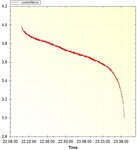podoljano
Junior Member level 2
Hi guys i have a little design issue. I am designing a board that will include a gps/gsm module, aswell a uController theese will run at 3.3V.
my problem is that i am powering this system with a litium polymer battery that has a nominal voltage of 3.7 volt. I belive that the battery will not be able to have a stable voltage to power my system(so i belive - if im wrong please correct me), therefore i must use a low dropout voltage regulator. the lowest i was able to find is a 3.3V Vout with 0.1V dropout voltage. This means the battery discharge below 3.41-3.42 volt will not be used. I have not been able to find any good information about discharge graphs on theese batteries.
The question is: how is much battery capacity am i loosing in this design? - is there better ways to do it? i really try to avoid using switch mode though, since the space is really crowded, plus the noise it creates..
thanks in advance
Nikolaj
my problem is that i am powering this system with a litium polymer battery that has a nominal voltage of 3.7 volt. I belive that the battery will not be able to have a stable voltage to power my system(so i belive - if im wrong please correct me), therefore i must use a low dropout voltage regulator. the lowest i was able to find is a 3.3V Vout with 0.1V dropout voltage. This means the battery discharge below 3.41-3.42 volt will not be used. I have not been able to find any good information about discharge graphs on theese batteries.
The question is: how is much battery capacity am i loosing in this design? - is there better ways to do it? i really try to avoid using switch mode though, since the space is really crowded, plus the noise it creates..
thanks in advance
Nikolaj

